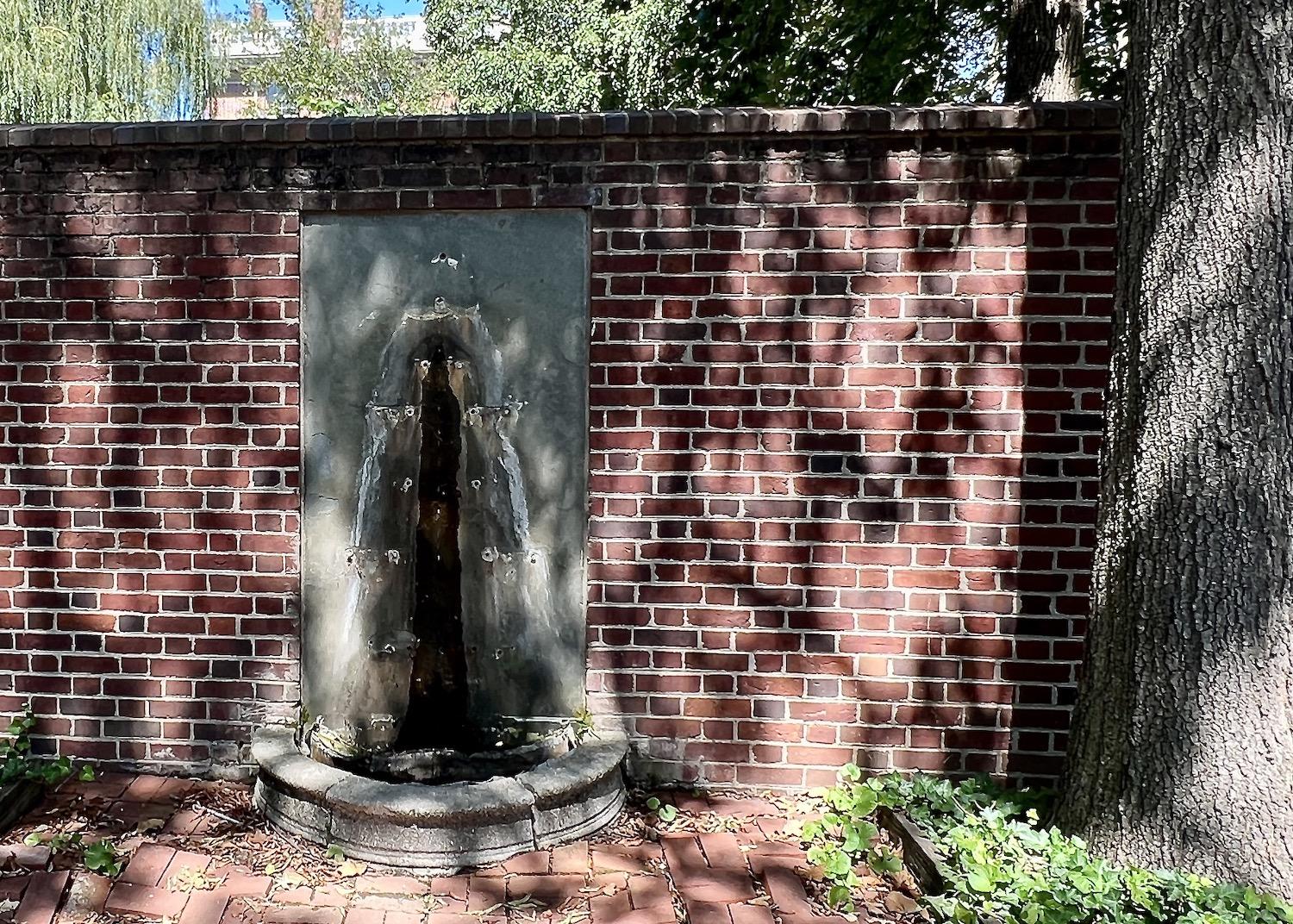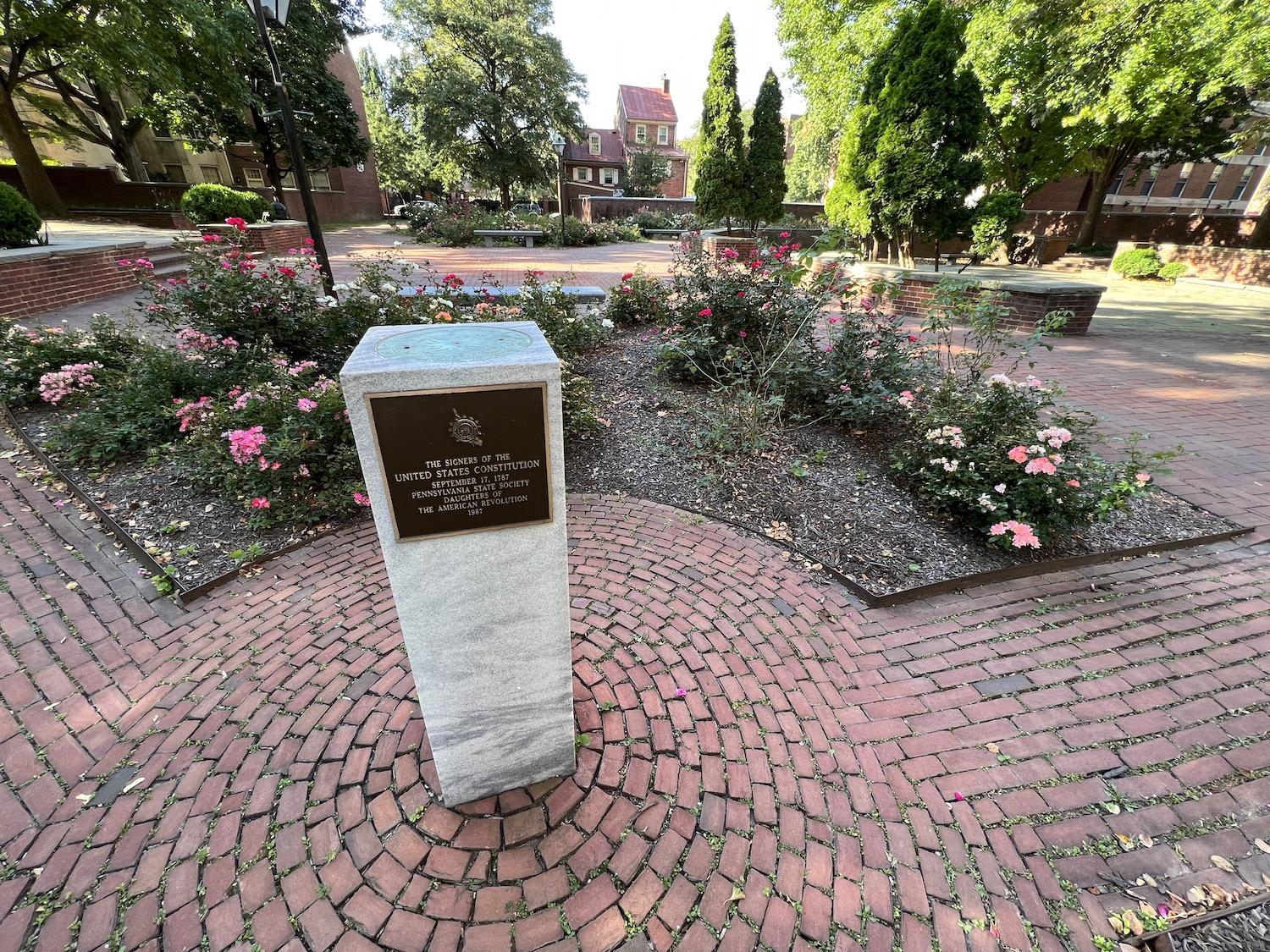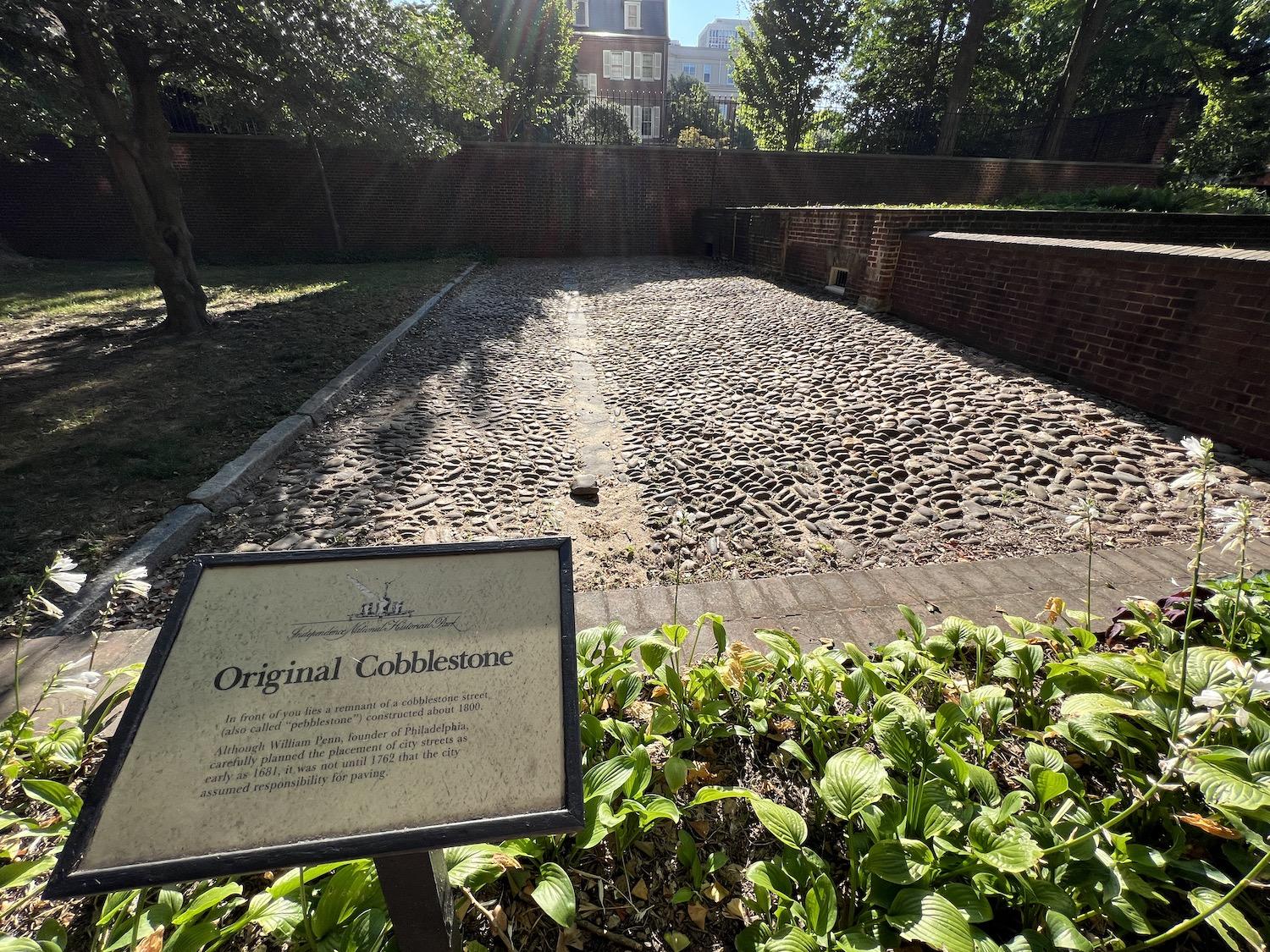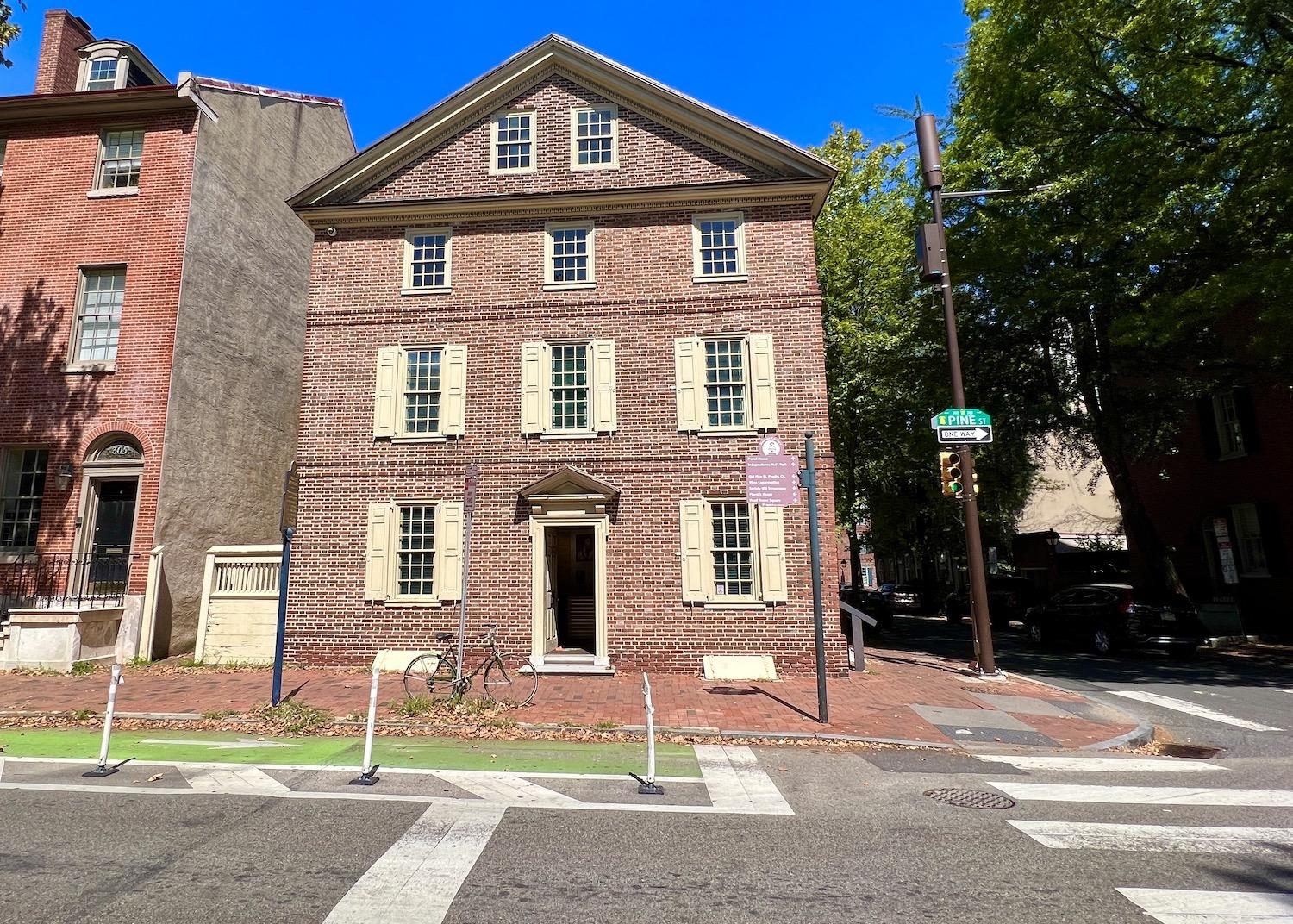
A rendering of how the Bicentennial Bell Garden will look in 2024 with the royal bell as a focal point/Courtesy of Independence Historical Trust
To commemorate the 200th anniversary of American independence in 1976, the people of Great Britain gave the people of the United States a gigantic bronze and tin bell presented by Queen Elizabeth II in Philadelphia and engraved with the words “Let freedom ring.”
And ring the Bicentennial Bell did for nearly four decades from its tower outside the visitor center at Independence National Historical Park. With each ring, it reminded people of the Queen’s gratitude to America’s Founding Fathers for teaching the British “to respect the right of others to govern themselves in their own way.”
The only problem was that nobody could actually see this bronze beauty that had been cast at the same place as the Liberty Bell — the Whitechapel Bell Foundry in London. And then in 2013, when it came time to demolish the visitor center, the bell was put in storage.

Queen Elizabeth II gave a speech in Philadelphia in July 1976 to dedicate the bicentennial bell as it found its first home at the Independence National Historical Park visitor center/NPS
Fast forward to September 2023 and I’m standing in the Benjamin Rush Garden with Natasha Calabria from the Independence Historical Trust, hearing about a new lease on life for this royal bell that symbolizes the shared heritage of the two nations and their relationship as allies.
This little-known garden at 3rd and Walnut Streets — which inexplicably isn't even marked on park maps — is expected to close soon and reopen next year as the Bicentennial Bell Garden. There will be ADA-compliant pathways, new lights and interpretive flowerbeds plus a restored fountain and the treasured bell.
The bell was cast with a mixture of copper and tin during a 16-minute pour back in 1976. At five feet and six inches tall, it's pretty much the same height as me. At 6 feet and 10 inches in diameter at its lip, it's a robust and substantial object.

Natasha Calabria, with the Independence Historical Trust, enjoys Benjamin Rush Garden before it's transformed into the Bicentennial Bell Garden. In the background you can see the Merchants' Exchange building (the park office), designed by noted Philadelphia architect William Strickland in the Greek Revival style and built between 1832 and 1834/Jennifer Bain
“The Liberty Bell weighs about 2,000 pounds, or one ton,” Calabria points out. “The Bicentennial Bell is about six tons. It’s a huge bell and that’s going to be right here in the center on an armature. The bottom of the bell will be 10ish feet off the ground so it really does make that kind of centrepiece or focal point. You’ll be able to see it if you’re walking around, and hopefully it will invite more people in.”
It would be nice, she adds, if somebody from the Royal Family could come and dedicate the garden. After all, this project will finally achieve the goal that was set when the Bicentennial Bell was cast 47 years ago which was, in the words of the trust, “to show the world that two great nations that started in strife and war can become great partners and allies.”
Holzman Iron Studio is producing the armature. Studio Bryan Hanes (the landscape architect) and park officials chose plants for the intrepretive garden that would have been traded between Great Britain and the United States during the 1700s and 1800s.

A June 1976 file photo shows the Bicentennial Bell being hoisted to its new home in the Independence National Historical Park visitor center as Denis Richards, British Consul General in Philadelphia, and park Superintendent Hobart Cawood look on/NPS
The garden project has been made possible by a $1 million pledge made by the Landenberger Family Foundation, whose directors Joseph Glyn and Eli Glyn said in 2020 that the bell “will testify to Philadelphia’s historical importance in the universal quest for freedom and democracy.”
Some work began while the remaining money needed for the garden is collected. The National Park Service is funding the garden construction and fountain restoration. News on that contract should be released soon.
For now, the under-appreciated green space spends its final days enduring an identity crisis. It’s on the park’s website but not on its paper maps. During my long weekend in Philly, I hear it called everything from Benjamin Rush Garden and Rush Garden to Bishop White Garden and Boxwood Garden.

The Benjamin Rush Garden as of September 2023 with Bishop White House in the background/Jennifer Bain
A 18th-century style garden with symmetrical planting beds bordered by low boxwood hedges, it sits on former site of Benjamin Rush House beside Bishop William White’s home.
Rev. Bishop William White was the beloved rector of Christ Church and St. Peter’s Church and his house has been restored to reflect the lifestyle of upper-class Philadelphians during the late 18th century.
I have to step through a flower bed to find an old sign about Rush under a tree by the fence. It says Rush lived in a three-storey house on this site from 1790 to 1793. “A true son of the Enlightenment, he was a physician, chemist, educator, author, abolitionist, and politician. His treatise on mental illness was the first in America.” Rush served as a delegate to the Continental Congress, signed the Declaration of Independence and supported ratification of the U.S. Constitution.

The fountain from Benjamin Rush Garden will be restored in 2024/Jennifer Bain
A showpiece fountain has been removed and the area by the brick fence where it once stood has been taken over by wasps. One side of the multi-level garden can only be accessed by steps.
Even so, this hidden gem is a tranquil spot.
“I actually have a feeling this will become our most popular wedding location,” predicts the park’s public affairs officer Andrew McDougall as he shows me around. “It’s so busy out there on the street and so loud. You step into the gardens and it brings the quiet you’re looking for — the respite.”

NPS public affairs officer Andrew McDougall shows off the 18th Century Garden at Independence National Historical Park/Jennifer Bain
Congress created Independence National Historical Park on June 28, 1948 to preserve and interpret Independence Hall, the Liberty Bell and other sites and museum collections associated with the American Revolution and growth of the country. In 2022, 2.7 million visitors spent $178 million in communities near the park. A gateway to the mid-Atlantic region, Independence is preparing for America's 250th birthday in 2026.
For now, the park began a year-long 75th birthday celebration on June 28. Somewhat daunted by the scope and depth of history to be learned here, I visited in September simply to explore its hidden gardens.
“I always love to see people hanging out in these little pocket gardens that we have because it is such a nice little retreat, especially in the city,” Calabria told me. “Normally when people think of Independence National Historical Park, they think of Independence Hall and the Liberty Bell and there’s a lot more than that. It’s 54ish acres and there are a lot of green spaces and a lot of gardens. It’s a really nice place to hang out and you almost forget that you’re in the city.”

Wedding photographers work quickly and quietly in the 18th Century Garden in Philadelphia/Jennifer Bain
Before COVID, the park issued about 300 permits a year for wedding photography. This year it expects that number to top 700.
Sure enough, as I tour gardens within walking distance of the soon-to-be Bicentennial Bell Garden, I find a wedding party using the 18th Century Garden as a backdrop for its photos.
Off Walnut Street between 3rd and 4th Streets, the 18th Century Garden is small but mighty with neat pathways, geometric raised flowerbeds, small fruit trees, and a vine-covered pergola that are all characteristic of early Philadelphia gardens. Volunteers from the Pennsylvania Horticultural Society planted and maintain this garden. Lady Bird Johnson, wife of President Lyndon B. Johnson, dedicated it to the Founding Fathers in 1966.

A September visit to the Rose Garden in Independence National Historical Park found some flowers still in bloom/Jennifer Bain
I find two more gardens along Locust street between 4th and 5th streets. These ones are noted on park maps.
The Rose Garden, north of Locust, was donated by the Daughters of the American Revolution in 1971 to honor those who signed the Declaration of Independence and the U.S. Constitution. The Magnolia Garden, south of Locust, was donated by the Garden Club of America in honor of the founders of the nation and dedicated in 1959.
The Rose Garden is still in bloom when I visit, lingering by an aging sign that proudly says: “Thomas Jefferson wrote that of all the countries in the world, America was where the noblest gardens may be made without expense.’”

A patch of historic cobblestone has been preserved in the Rose Garden in Philadelphia's Independence National Historical Park/Jennifer Bain
This garden apparently houses 96 varieties of antique roses. Unlike modern hybrid roses, the majority of the roses in this garden reportedly only bloom once a year, usually in late spring. There's also an interesting patch of cobblestone.
"In front of you lies a remnant of a cobblestone street (also called "pebblestone") constructed about 1800," another aging sign reveals. "Although William Penn, founder of Philadelphia, carefully planned the placement of city streets as early as 1681, it was not until 1762 that the city assumed responsibility for paving."

Vintage benches are a highlight in the Magnolia Garden at Independence National HIstorical Park when the magnolias aren't blooming/Jennifer Bain
My final visit is to tiny Magnolia Garden, where a sign says: “Please help keep this garden beautiful. Stay out of the plant beds. Keep dogs on leash at all times. Pick up after your dog. Stay out of the fountain. Thank you.”
Of course, the first thing I see is someone unleashing their dog, a problem I’ve witnessed in countless parks across the United States and Canada.
Anyway, this garden is surrounded by a red brick wall, wrought iron fences and gates, and apparently 13 early spring blooming hybrid magnolias that are suitable for northern climates and represent the 13 original colonies. The plantings are said to include Saucer Magnolias, Narcissus Snow Azaleas, English Oak, Honey Locusts and Cotoneasters plus a ground cover of English Ivy.

The Magnolia Garden boasts a walled green space and fountain that seems to tempt dog owners into unleashing their pets/Jennifer Bain
"George Washington, who lived in Philadephia during his Presidency, retained a lively interest in horticulture," yet another aging sign explains of the inspiration for this space. "His letters reveal that magnolias were among the trees he hoped to grow. Although the magnolias in this garden are a different from that mentioned by Washington, he would have enjoyed their delicate pink flowers each spring."
Since it's September, the magnolias are no longer in bloom and so I take a few minutes to admire the next best things — a refreshingly simple vintage water fountain and fabulously retro white iron benches from the 1950s.
While You’re in Philadelphia:

At 0.02 acres, Thaddeus Kosciuszko National Memorial in Philadelphia is the smallest unit in the National Park Service/Jennifer Bain
At 3rd and Pine Streets, just a quick walk from the Liberty Bell Center and Independence Hall, stands a red brick house that is quietly the smallest unit in the national park system.
Thaddeus Kosciuszko National Memorial uses just 0.02 acres of land to honor a Polish military engineer and humanitarian who Thomas Jefferson famously said was “as pure a son of liberty as I have ever known.”
Visits start with a challenge to correctly pronounce the name of the man who lived here in the winter of 1797-1798 when it was a boarding house, entertaining guests like Vice President Thomas Jefferson and Chief Little Turtle of the Miami Nation. (It's KOS-CHOOS-KO.)

Signage by the entrance of Thaddeus Kosciuszko National Memorial helps you pronounce the Polish freedom fighter's name/Jennifer Bain
A respected military engineer and Polish national, Kosciuszko served the United States in the Continental Army, making important contributions to the American Revolutionary War effort, most notably including the design and construction of fortifications at Saratoga and West Point in New York.
Kosciuszko championed human rights and freedom, led an insurrection of his native Poland against Tsarist Russia, and left a will directing his estate be used to free as many slaves as possible.
The main floor of Kosciuszko House has exhibits and a visitor contact station. Dedicated as a national memorial in 1972, the NPS restored the building’s exterior and second-floor bedroom to its 1797-1798 appearance when Kosciusko resided there while recovering from wounds suffered while fighting for Poland.
The seasonal site, managed by Independence National Historical Park, is usually open weekends between April and October. If you want more on this fascinating man, artist Marian Konieczny's 1977 bronze statue, General Tadeusz Kosciuszko, can be found at 18th Street and Benjamin Franklin Parkway. The parkway is famous for its public art collection.

The famous and ever-popular Liberty Bell can be viewed from outside the Liberty Bell Center at night/Jennifer Bain
Strategically using the Kimpton Hotel Monaco Philadelphia as my base, I am just minutes from the Thaddeus site, hidden gardens and Zahav, a landmark Israeli restaurant I've long wanted to try. It's admittedly a hike to Reading Terminal Market for the rest of my multicultural meals, but I'm right across the street from the Liberty Bell and Independence Hall. This makes it easy to beat to the Liberty Bell Center lineups by going right when it opens, but also to see it lit up at night when you can view it through the windows.
Park ranger Anna Godzik, who I find stationed at Thaddeus Kosciuszko National Memorial one day and the Liberty Bell Center the next, gives a spirited but abbreviated talk about the bell's famous cracks. The first crack was fixed in 1846 for George Washington's birthday celebration, but after ringing it for just three hours, a second more extensive crack appeared that snakes right through the word liberty and silenced the bell forever.
"As noticeable as the crack is, and that's how we recognize the Liberty Bell, it's really not what makes the bell special," Godzik tells the early morning crowd. "It's this inscription here. And it says `Proclaim liberty throughout all the land unto all the inhabitants thereof.' Nowhere does it same man or woman, black or white, or a certain religion. It says all inhabitants." Abolitionists immediately seized on this message, and since then the women's suffrage, gay right's and civil rights movements have been among those inspired by the timeless message.
"Even today I think on an unconscious level I think a lot of us have come here because we all want a piece of that liberty, whatever that means to us in that context today," Godzik concludes. "That's a really long way of sayng that's what really makes it special. The crack just makes it broken."

NPS ranger Anna Godzik shares insights about the Liberty Bell at the Liberty Bell Center in Philadelphia/Jennifer Bain





